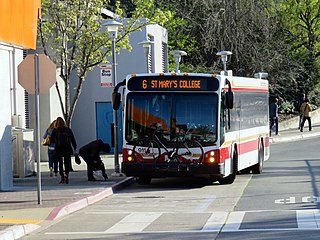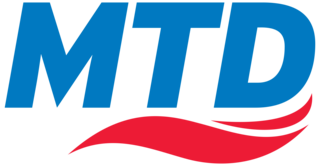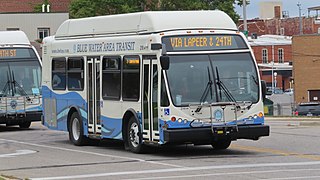
The County Connection is a Concord-based public transit agency operating fixed-route bus and ADA paratransit service in and around central Contra Costa County in the San Francisco Bay Area. Established in 1980 as a joint powers authority, CCCTA assumed control of public bus service within central Contra Costa first begun by Oakland-based AC Transit as it expanded into suburban Contra Costa County in the mid-1970s. In 2023, the system had a ridership of 2,661,400, or about 9,600 per weekday as of the first quarter of 2024.

Hillsborough Area Regional Transit provides public transportation for Hillsborough County, Florida. The agency operates fixed-route local and express bus service, paratransit service, demand-response service, MetroRapid service, and the TECO Line Streetcar system. In 2023, the system had a ridership of 12,929,700.

Lynx is a transit system serving the greater Orlando, Florida area. Operated by the Central Florida Regional Transportation Authority, it provides bus, curb-to-curb, and paratransit services in three counties: Orange, Seminole, and Osceola. Bus routes are referred to as Links.

The Champaign–Urbana Mass Transit District is a mass transit system that operates in the Champaign–Urbana metropolitan area in central-eastern Illinois. MTD is headquartered in Urbana and operates its primary hub at the intermodal Illinois Terminal in downtown Champaign. In 2023, the system had a ridership of 8,947,600, or about 39,200 per weekday as of the first quarter of 2024.

The San Diego Trolley is a light rail system operating in the metropolitan area of San Diego. The Trolley's operator, San Diego Trolley, Inc., is a subsidiary of the San Diego Metropolitan Transit System (MTS). The trolley operates as a critical component of the MTS, with connections to and integrated travel tickets with the local bus systems.
The Greater Dayton Regional Transit Authority, formerly known as the Miami Valley RTA, is a public transit agency that generally serves the greater Dayton, Ohio area. The GDRTA serves communities within Montgomery County and parts of Greene County, Ohio, USA. There are 18 routes. RTA operates diesel and electric trolley buses seven days a week, 21 hours a day, and provides services to many citizens within the area. RTA's current CEO is Bob Ruzinsky. In 2023, the system had a ridership of 6,570,600, or about 24,400 per weekday as of the first quarter of 2024.

Hampton Roads Transit (HRT), incorporated on October 1, 1999, began through the voluntary merger of PENTRAN on the Virginia Peninsula and TRT in South Hampton Roads and currently serves over 22 million annual passengers within its 369-square-mile (960 km2) service area around Hampton Roads. The purpose of the HRT is to provide reliable and efficient transportation service and facilities to the Hampton Roads community. In 2023, the system had a ridership of 7,263,900, or about 28,000 per weekday as of the first quarter of 2024.

The Memphis Area Transit Authority (MATA) is the public transportation provider for Memphis, Tennessee. It is one of the largest transit providers in the state of Tennessee; MATA transports customers in the City of Memphis and parts of Shelby County on fixed-route buses, paratransit vehicles, demand-responsive service, and the MATA Trolley system. The system is managed by a seven-member policy board appointed by the mayor and approved by the Memphis City Council. In 2023, the system had a ridership of 3,122,700.

A tourist trolley, also called a road trolley, is a rubber-tired bus designed to resemble an old-style streetcar or tram, usually with false clerestory roof. The vehicles are usually fueled by diesel, or sometimes compressed natural gas.

Embark is the public transit agency of the COTPA trust, the largest transit agency in the state of Oklahoma. Embark has 20 interconnecting bus routes covering the city of Oklahoma City and parts of the Oklahoma City Metropolitan Area, including weekday Express service from Norman to Downtown Oklahoma City. Embark also operates paratransit, the Oklahoma City Streetcar, downtown public parking, bike share, and river ferry services. Additionally, Embark provides administrative and executive support for the Regional Transportation Authority of Central Oklahoma.

Tucson Transit Management LLC, doing business as Sun Tran, is the public transit system serving the city of Tucson, Arizona. In 2023, the system had 17,361,800 rides, or about 59,900 per weekday as of the first quarter of 2024. 100% of the fleet utilizes clean-burning fuels, such as compressed natural gas (CNG), biodiesel, and hybrid technologies. In addition to more than 40 bus routes, the system also includes the Sun Link modern streetcar line.

The San Diego Metropolitan Transit System is a public transit service provider for central, southern, northeast, and southeast San Diego County, California, as well as for the city of San Diego. The agency directly operates a large transit system that includes the MTS Bus, San Diego Trolley light rail, and Rapid bus rapid transit services. The MTS also controls the San Diego and Arizona Eastern (SD&AE) freight railway and regulates taxicabs, jitneys, and other private for-hire passenger transportation services.
The Pinellas Suncoast Transit Authority (PSTA) is a government agency that provides public transportation for Pinellas County, Florida. The authority manages a fixed-route bus system that encompasses over 40 bus routes - including two express routes to Tampa; the Central Avenue Trolley; the Suncoast Beach Trolley; and the bus rapid transit service, the SunRunner.
The Riverview Corridor is a transit corridor connecting Downtown Saint Paul and the Mall of America in Bloomington via the Minneapolis-Saint Paul International Airport. The corridor serves an area from the Saint Paul Union Depot to the Mall via a route along West 7th Street, which runs southwest from Downtown Saint Paul. The corridor creates a triangle connecting opposite ends of the Blue Line and Green Line.

The Portage Area Regional Transportation Authority, commonly referred to as PARTA, is a transit agency serving Portage County, Ohio. It is headquartered in Franklin Township just outside the Kent city limits. PARTA was formed in 1975 from an agreement between the city of Kent and Franklin Township and has since expanded to include routes over much of Portage County. It operates several local routes including circulator and suburban routes in Kent, and an interurban route connecting Ravenna, Kent, and Stow. PARTA also offers express routes including services into downtown Cleveland, Akron as well as weekday service to the rural Portage County communities of Windham, Garrettsville and Hiram. In addition, PARTA includes Kent State University's Campus Bus Service, which it acquired in 2004, and a dial-a-ride service. A proposed plan to acquire Lorain County Transit to serve better bus service in Lorain County. In 2023, the system had a ridership of 903,300.

The Regional Transportation Commission of Washoe County (RTC) is the public body responsible for the transportation needs throughout Reno, Sparks and Washoe County, Nevada. The RTC, founded by the Nevada Legislature in 1979, is an amalgamation of the Regional Street and Highway Commission, the Regional Transit Commission and the Washoe County Area Transportation Study Policy Committee. They provide public transportation services, street and highway construction, and transportation planning. In 2023, the system had a ridership of 5,162,600, or about 16,200 per weekday as of the first quarter of 2024.

Transfort is the public transportation operator for the City of Fort Collins, Colorado. The system offers 22 regular routes, with 20 of them providing all-day service Monday through Friday. Six-day intercity service is provided by the FLEX to Loveland, Berthoud, and Longmont. Additionally, five routes for transporting Colorado State University students, faculty and staff run throughout the school year. In 2023, the system provided transportation services to 2,086,500 people.

Blue Water Area Transit (BWAT) is the public transit operator serving Port Huron, Michigan and surrounding St. Clair County. Operated by the Blue Water Area Transportation Commission (BWATC), the BWAT system includes fixed-route buses in the Port Huron area, plus commuter routes and paratransit services. In 2023, the system had a ridership of 1,013,200, or about 3,800 per weekday.

The Dayton trolleybus system forms part of the public transportation network serving Dayton, in the state of Ohio, United States. Opened on April 23, 1933, it presently comprises five lines, and is operated by the Greater Dayton Regional Transit Authority, with a fleet of 45 trolleybuses. In 2023, the system had a ridership of 2,163,400, or about 6,000 per weekday as of the first quarter of 2024.

The Metro A Line is a bus rapid transit line in the Twin Cities, Minnesota operated by Metro Transit. The A Line operates primarily along the Snelling Avenue corridor and travels through the cities of Minneapolis, Saint Paul, Falcon Heights, and Roseville. From the Blue Line in Minneapolis, the line travels past Minnehaha Park, through the Highland Village commercial area, past Macalester College, and connects to the Green Line near Allianz Field. The line continues through Saint Paul, past Hamline University, before traveling through Falcon Heights and Roseville, where the line passes the Minnesota State Fairgrounds, Har Mar Mall, and terminates at Rosedale Center.
























